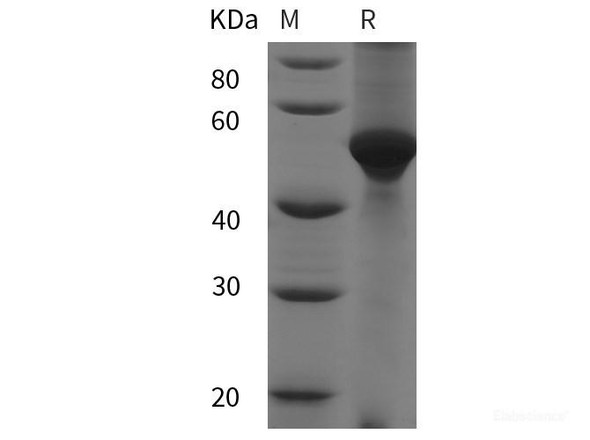Enzymes Recombinant Proteins
Human LPL Recombinant Protein (RPPB1911)
- SKU:
- RPPB1911
- Product Type:
- Recombinant Protein
- Species:
- Human
- Uniprot:
- P06858
- Research Area:
- Enzymes
Description
| Product Name: | Human LPL Recombinant Protein |
| Product Code: | RPPB1911 |
| Size: | 10µg |
| Species: | Human |
| Target: | LPL |
| Synonyms: | Lipoprotein lipase, LPL, LIPD, HDLCQ11. |
| Source: | Escherichia Coli |
| Formulation: | LPL was filtered (0.4 �m) and lyophilized�from 0.5 mg/ml in 50mM Acetate buffer, pH=4. |
| Solubility: | It is recommended to add 0.1M Acetate buffer pH4 to prepare a working stock solution of approximately 0.5 mg/ml and let the lyophilized pellet dissolve completely. For conversion into higher pH value, we recommend intensive dilution by relevant buffer to a concentration of 10�g/ml. In higher concentrations the solubility of this antigen is limited. Product is not sterile! Please filter the product by an appropriate sterile filter before using it in the cell culture. |
| Stability: | Store lyophilized protein at -20°C. Aliquot the product after reconstitution to avoid repeated freezing/thawing cycles. Reconstituted protein can be stored at 4°C for a limited period of time; it does not show any change after two weeks at 4°C. |
| Amino Acid Sequence: | MKHHHHHHAS ADQRRDFIDI ESKFALRTPE DTAEDTCHLI PGVAESVATC HFNHSSKTFM VIHGWTVTGM YESWVPKLVA ADQRRDFIDI ESKFALRTPE DTAEDTCHLI PGVAESVATC HFNHSSKTFM VIHGWTVTGM YESWVPKLVA ALYKREPDSN VIVVDWLSRA QEHYPVSAGY TKLVGQDVAR FINWMEEEFN YPLDNVHLLG YSLGAHAAGI AGSLTNKKVN RITGLDPAGP NFEYAEAPSR LSPDDADFVD VLHTFTRGSP GRSIGIQKPV GHVDIYPNGG TFQPGCNIGE AIRVIAERGL GDVDQLVKCS HERSIHLFID SLLNEENPSK AYRCSSKEAF EKGLCLSCRK NRCNNLGYEI SKVRAKRSSK MYLKTRSQMP YKVFHYQVKI HFSGTESETH TNQAFEISLY GTVAESENIP FTLPEVSTNK TYSFLIYTEV DIGELLMLKL KWKSDSYFSW SDWWSSPGFA IQKIRVKAGE TQKKVIFCSR EKVSHLQKGK APAVFVKCHD KSLNKKSG |
LPL is a lipoprotein lipase, which is expressed in the heart, muscle, and adipose tissue. LPL acts as a homodimer, and has the dual functions of triglyceride hydrolase and ligand/bridging factor for receptor-mediated lipoprotein uptake. Type I hyperlipoproteinemia is a result of severe mutations which cause LPL deficiency, whereas less extreme mutations in LPL are linked to many disorders of lipoprotein metabolism. Lipoprotein lipase (LPL) is a fundamental enzyme in plasma triglyceride hydrolysis and is secreted by macrophages in the subendothelial space. LPL also promotes the development of atherosclerosis through facilitation of monocyte adhesion to endothelial cells, stimulation of tumor necrosis factor alpha (TNF) secretion and induction of vascular smooth muscle cell proliferation.
The Recombinant Human LPL produced in E.coli�has a molecular mass of 51.61kDa containing�458 amino acid residues of the human LPL and fused to a�10 a.a. His tag at N-terminus.
| UniProt Protein Function: | LPL: The primary function of this lipase is the hydrolysis of triglycerides of circulating chylomicrons and very low density lipoproteins (VLDL). Binding to heparin sulfate proteogylcans at the cell surface is vital to the function. The apolipoprotein, APOC2, acts as a coactivator of LPL activity in the presence of lipids on the luminal surface of vascular endothelium. Defects in LPL are the cause of lipoprotein lipase deficiency (LPL deficiency); also known as familial chylomicronemia or hyperlipoproteinemia type I. LPL deficiency chylomicronemia is a recessive disorder usually manifesting in childhood. On a normal diet, patients often present with abdominal pain, hepatosplenomegaly, lipemia retinalis, eruptive xanthomata, and massive hypertriglyceridemia, sometimes complicated with acute pancreatitis. Belongs to the AB hydrolase superfamily. Lipase family. |
| UniProt Protein Details: | Protein type:Membrane protein, GPI anchor; EC 3.1.1.34; Lipid Metabolism - glycerolipid; Phospholipase Chromosomal Location of Human Ortholog: 8p22 Cellular Component: extracellular matrix; extracellular space; chylomicron; cell surface; plasma membrane; extracellular region Molecular Function:heparin binding; triacylglycerol lipase activity; protein binding; lipoprotein lipase activity; apolipoprotein binding; phospholipase activity; receptor binding; triglyceride binding Biological Process: response to drug; phototransduction, visible light; triacylglycerol metabolic process; phospholipid metabolic process; triacylglycerol catabolic process; lipoprotein metabolic process; triacylglycerol biosynthetic process; response to cold; retinoid metabolic process; fatty acid biosynthetic process Disease: Hyperlipoproteinemia, Type I; Hyperlipidemia, Familial Combined |
| NCBI Summary: | LPL encodes lipoprotein lipase, which is expressed in heart, muscle, and adipose tissue. LPL functions as a homodimer, and has the dual functions of triglyceride hydrolase and ligand/bridging factor for receptor-mediated lipoprotein uptake. Severe mutations that cause LPL deficiency result in type I hyperlipoproteinemia, while less extreme mutations in LPL are linked to many disorders of lipoprotein metabolism. [provided by RefSeq, Jul 2008] |
| UniProt Code: | P06858 |
| NCBI GenInfo Identifier: | 4557727 |
| NCBI Gene ID: | 4023 |
| NCBI Accession: | NP_000228.1 |
| UniProt Secondary Accession: | P06858,Q16282, Q16283, Q96FC4, B2R5T9, |
| UniProt Related Accession: | P06858 |
| Molecular Weight: | 53,162 Da |
| NCBI Full Name: | lipoprotein lipase |
| NCBI Synonym Full Names: | lipoprotein lipase |
| NCBI Official Symbol: | LPL�� |
| NCBI Official Synonym Symbols: | LIPD; HDLCQ11�� |
| NCBI Protein Information: | lipoprotein lipase |
| UniProt Protein Name: | Lipoprotein lipase |
| Protein Family: | Lipoprotein |
| UniProt Gene Name: | LPL�� |
| UniProt Entry Name: | LIPL_HUMAN |






